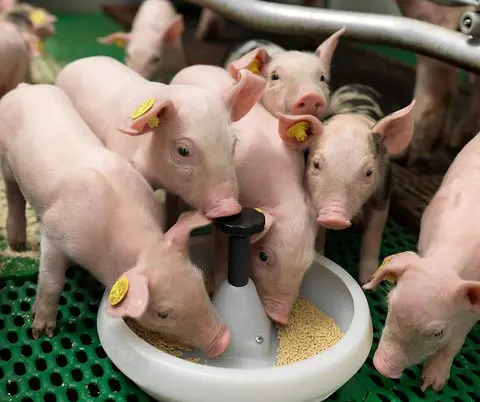
There are a few important reasons why piglets should be supplemented with feed in the farrowing house:
- Piglets are born with low levels of amylase and high levels of lactase. This initial enzyme profile gears the piglet to digest milk protein, but not for the vegetable and/or animal protein found in solid feeds. Feed supplementation in the farrowing room allows a kickstart to change this enzyme profile.
- Sows’ milk and post-weaning fasting both have negative effects on the length of the intestinal villi. The earlier the piglet is exposed to a solid diet, the less subsequent diarrhoea and adaptation issues will develop later on.
- The reason for supplementing piglets with creep feeds is to minimise the number of under-developed/under-adapted animals during the first days after weaning and, because it is beneficial for both 21-day and 28-day lactations.
Food intake
Special attention has to be paid to the role of food (energy) intake as a mediator of intestinal structure and function after weaning, although other influences, such as the source of protein added to the diet, may interact with food intake to alter gut structure and function. This is clearly an area of production concern, and future research into areas such as the manipulation of the immature digestive tract with exogenous growth factors and/or dietary supplementation with ‘non-essential’ amino acids such as glutamine, appear warranted.
Learning to eat at an early stage is one way to smooth the transition at weaning with minimal performance checks. Creep feeding is the “art” of feeding a solid diet to piglets while they are suckling the sow and thus preparing their digestive systems for weaning. These initiates and promotes gut and digestive enzyme development, which enables the piglet to digest nutrients from food sources other than that of milk. This encourages feed intake, which is one of the greatest challenges to post-weaning performance. Creep feeding becomes increasingly important and beneficial as weaning age increases. As piglets grow their requirement for nutrients increases and this requirement eventually surpasses what the sow is able to supply as milk yield peaks at around three weeks and then slowly declines.
Figure 1. Piglet growth on sow milk only and sow milk plus creep feed
Encouraging creep intake
- To make the transition as smooth as possible use the same creep pre-weaning and immediately post-weaning.
- Offer good quality, palatable and highly digestible feed which piglets will find appealing.
- Ensure that there is an accessible supply of fresh water as this will influence feed intake.
- Pellets and blends of pellets with mash (meal and water) are also very effective, and generally result in less wastage.
- Position creep feed away from corners, drinkers and heat lamps to minimise the likelihood of fouling it.
- In each litter some piglets will be eating nothing at all, even when the other piglets are eating well. Watch out for these piglets and manage them carefully to prevent them from falling behind.
Basics of good creep feeding
- Keep creep feed fresh and clean and out of reach of the sow.
- Initiate exposure to creep at 3 to 5 days of age, or according to the manufacturer's recommendations.
- Begin by offering creep on a flat surface, for example, a shallow tray (heavy metal or plastic trays that can hook into the slats).
- Place trays close to the piglets but not under direct heat as this will turn the feed stale too quickly. Also, keep feed away from the dunging area.
- Begin with very small amounts replaced at least twice a day, preferably more often. Always remove all uneaten creep; only un-medicated waste creep may be fed to the sow.
- Offer creep when the sows are feeding as the piglets will be active and they will not be suckling.
- Do not overfeed - feed to appetite. This is where the “art” comes into play.
- Introduce small troughs or top up the trays often if litters are eating well.
- Always clean any fouled trays or troughs.
- Store creep feed in a cool, dry place and always close bags to prevent feed taking up the farrowing house odours and/or becoming rancid.
- Commitment to creep feeding is always successful if enough time and effort is devoted to it.
- Remember the importance of the sow: It is crucial to maximise milk yield as she will be providing the majority of the piglet's nutrition. Creep helps the gut to develop and to adapt to be able to utilise solid feed and has a minimal influence on weaning weight.
References: www.wageningenacademic.com/, www.thepigsite.com/articles/4226/creep-feeding, Voluntary feed intake in pigs – David Torrrallardona & Eugene Roma – 2009, Auction for productivity pork.ahdb.org.uk/media/1987/action-creep-feeding

